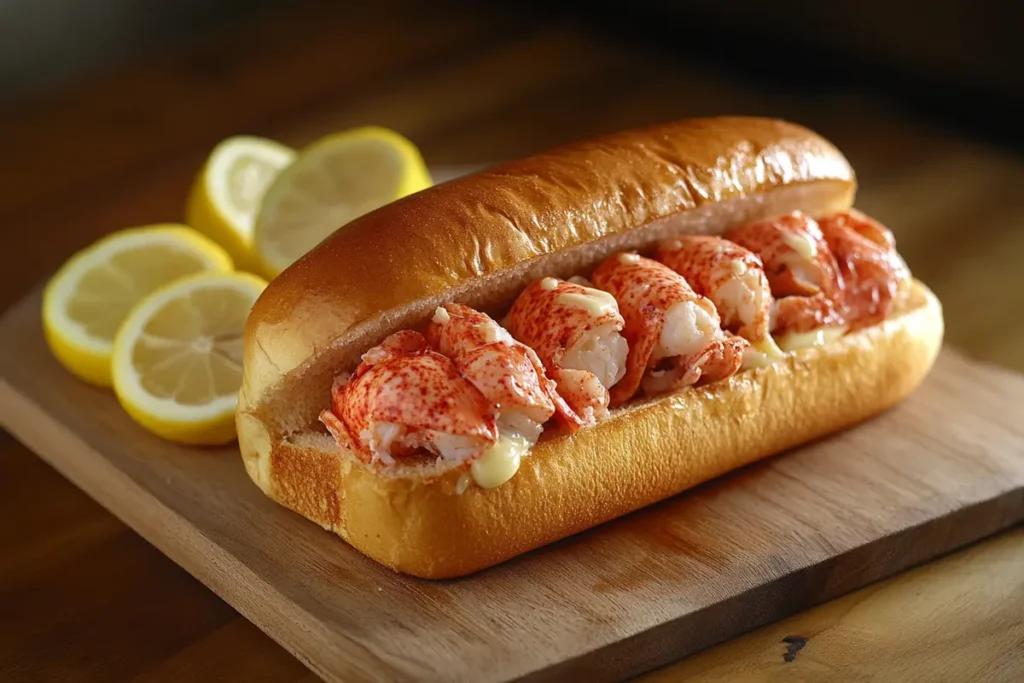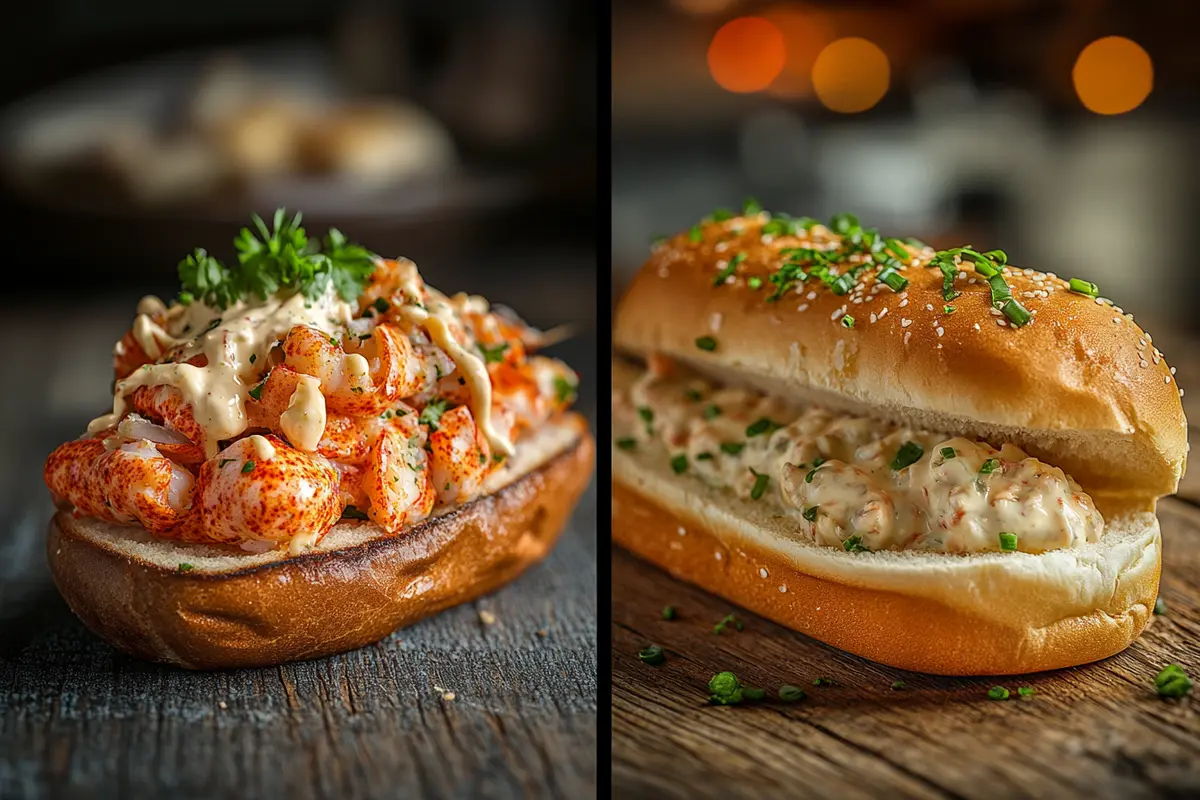When it comes to iconic seafood dishes, the question “Which Style Lobster Roll Is Best?” sparks a delicious debate among food lovers. Few creations are as beloved as the lobster roll, a summertime staple in coastal areas of the United States. However, a long-standing rivalry divides fans into two camps: Maine style and Connecticut style.
Each style offers a unique take on the lobster roll, from the temperature of the lobster to the type of bread and toppings that define its flavor. Whether you prefer the buttery warmth of a Connecticut roll or the refreshing coolness of a Maine roll, this iconic dish has something for everyone.
In this article, we’ll explore the defining characteristics of each style, compare their key differences, and even dive into some creative variations. By the end, you’ll know the answer to “Which Style Lobster Roll Is Best?” for your taste buds. Let’s dig in!
Table of Contents
Overview of Lobster Rolls
Lobster rolls are more than just a sandwich – they’re a symbol of summer, seaside vacations, and indulgent dining. Their simplicity is part of their charm, yet the preparation and ingredients vary depending on the style. But which style lobster roll is best? Let’s break down the basics of what makes a lobster roll so special.
What Is a Lobster Roll?
At its core, a lobster roll is a sandwich filled with chunks of fresh lobster meat. Typically served on a toasted or buttered roll, the ingredients and preparation depend on regional preferences. This leads to the long-standing debate: Which style lobster roll is best—the creamy, mayo-based Maine style or the buttery, warm Connecticut style?
Traditionally, lobster rolls are a coastal favorite, especially in New England, where lobster fishing thrives. Freshness is key, with many establishments proudly serving lobster caught the same day. Regardless of the style, the lobster roll’s appeal lies in its simplicity and the quality of its ingredients.
Key Ingredients in a Lobster Roll
The beauty of a lobster roll lies in its simplicity. Here’s what you can expect in a classic lobster roll:
- Lobster Meat: The star of the show, usually claw, knuckle, and tail meat.
- Bread: A split-top roll or bun, often toasted or grilled for added texture.
- Condiments: This depends on the style. Maine rolls typically use mayonnaise, while Connecticut rolls favor melted butter.
- Seasoning: Light touches of salt, pepper, and sometimes fresh herbs like parsley or chives.
While these are the basic components, many chefs put their own spin on the recipe, adding ingredients like celery for crunch or lemon juice for brightness.
The Regional Divide: Maine vs. Connecticut
When debating which style lobster roll is best, the divide between Maine and Connecticut styles inevitably takes center stage. Both styles hail from the New England region, but their differences have sparked a passionate debate among seafood lovers.
- Maine Style: This lobster roll is served cold, featuring a creamy, mayonnaise-based dressing often enhanced with a touch of celery or lemon juice for added freshness.
- Connecticut Style: Served warm, this version drizzles melted butter over the lobster meat, delivering a rich, indulgent flavor that contrasts with the chilled Maine style.
Each style brings its own unique charm to the table, and both are worth trying. Deciding which style lobster roll is best often comes down to personal taste – whether you prefer the refreshing coolness of the Maine style or the buttery decadence of the Connecticut style.
Maine Lobster Roll

The Maine lobster roll is often considered the quintessential version of this iconic sandwich. Its refreshing flavors and simple preparation make it a favorite among seafood lovers, especially during warm summer months. Let’s explore what makes the Maine lobster roll so unique and why it continues to stand out.
What Defines a Maine Lobster Roll?
The Maine lobster roll is defined by its cool, creamy filling. This style uses fresh lobster meat that’s lightly dressed in mayonnaise, creating a smooth and satisfying texture. Unlike its Connecticut counterpart, the Maine roll is served cold, making it an ideal choice for those who prefer lighter, more refreshing flavors.
Key characteristics of a Maine lobster roll include:
- Cold Lobster Meat: The lobster is chilled after cooking, preserving its natural sweetness.
- Mayonnaise Base: A light coating of mayo binds the lobster meat together, enhancing its creamy texture.
- Optional Additions: Some recipes include finely chopped celery for a bit of crunch or a dash of lemon juice for acidity.
- Split-Top Bun: The roll is typically toasted on the outside, creating a golden-brown crust that contrasts beautifully with the cool filling.
Flavor Profile: Cold and Refreshing
When considering which style lobster roll is best, the Maine lobster roll stands out for its clean and refreshing flavor. The cold lobster meat is perfectly complemented by the slight tanginess of mayonnaise, while a toasted bun provides just the right amount of crunch. This balance of textures and flavors makes the Maine style a favorite for many.
The addition of lemon juice or fresh herbs like chives or parsley further brightens the flavor, making it an ideal choice on a hot summer day. Maine lobster rolls aren’t about overpowering the natural taste of lobster – they focus on enhancing it with simple, fresh ingredients.
Why Do People Love Maine Lobster Rolls?
Maine lobster rolls have earned a devoted following for several reasons:
- Simplicity: The recipe is straightforward, allowing the lobster to take center stage.
- Freshness: In Maine, the lobster is often caught the same day it’s served, guaranteeing unparalleled freshness.
- Versatility: While it’s traditionally served as-is, the Maine lobster roll can be customized with add-ins like celery, scallions, or even a dash of hot sauce.
- Accessibility: This style is widely available at seafood shacks, upscale restaurants, and even food trucks across New England.
Moreover, the Maine lobster roll is perfect for those who enjoy chilled seafood dishes, as it delivers a light, refreshing experience that’s hard to beat.
Connecticut Lobster Roll

While the Maine lobster roll is celebrated for its cool and creamy style, the Connecticut lobster roll offers a contrasting approach that sparks the debate over which style lobster roll is best. Served warm and generously slathered in melted butter, this version emphasizes richness and decadence.
For many seafood enthusiasts, the Connecticut lobster roll embodies comfort food at its finest, delivering a buttery, indulgent experience that highlights the natural sweetness of the lobster.
What Defines a Connecticut Lobster Roll?
The Connecticut lobster roll is a warm, buttery creation that highlights the natural sweetness of lobster meat. Unlike its Maine counterpart, this version foregoes mayonnaise and instead relies on melted butter to bring out the lobster’s flavor. It’s served hot, making it the perfect indulgence on a breezy evening by the shore.
Key characteristics of a Connecticut lobster roll include:
- Warm Lobster Meat: The lobster is gently warmed, often sautéed or steamed with butter.
- Melted Butter: Instead of mayo, the lobster is generously coated in butter, enhancing its flavor and juiciness.
- Minimal Additions: The focus is squarely on the lobster, with little to no additional ingredients.
- Buttered, Toasted Roll: The bun is typically toasted and buttered, adding to the dish’s overall richness.
Flavor Profile: Warm and Buttery
The Connecticut lobster roll is all about indulgence. The warmth of the lobster meat, combined with the richness of melted butter, creates a flavor profile that feels luxurious yet comforting. The butter amplifies the natural sweetness of the lobster, making every bite incredibly satisfying.
The toasted roll further elevates the experience, adding a subtle crunch and buttery aroma. This version is ideal for those who enjoy rich, savory flavors and prefer their seafood served warm.
Why Do People Love Connecticut Lobster Rolls?
Connecticut lobster rolls have earned their loyal fanbase for a variety of reasons:
- Richness: The melted butter gives the lobster a decadent, mouthwatering quality.
- Warmth: Serving the lobster warm makes it feel more like a hearty meal than a light snack.
- Simplicity: By keeping the recipe minimal, the Connecticut roll allows the lobster’s natural flavor to shine.
- Comfort: Many people associate warm dishes with comfort, and this roll is no exception.
Another reason for the Connecticut roll’s popularity is its ability to showcase the lobster’s freshness. Without mayonnaise or other ingredients to compete with, the flavor of the lobster truly takes center stage. It’s the perfect choice for those who prefer a more straightforward and buttery take on this classic dish.
Key Differences Between Maine and Connecticut Styles
When deciding which style lobster roll is best, it’s essential to compare the defining characteristics of Maine and Connecticut lobster rolls head-to-head. While both styles celebrate the deliciousness of lobster, their preparation and presentation offer entirely unique dining experiences.
Here are the main differences that set these two iconic styles apart and help determine which style lobster roll is best for your taste.
Serving Temperature: Cold vs. Warm
The most obvious difference between the two styles is the temperature at which the lobster is served:
- Maine Lobster Roll: Served cold, which makes it refreshing and ideal for hot summer days.
- Connecticut Lobster Roll: Served warm, creating a cozy and indulgent feel.
For many, this difference alone determines their preference. Some love the cool, crisp bite of the Maine roll, while others crave the comforting warmth of the Connecticut version.
Butter vs. Mayo Debate
The type of dressing is another major point of distinction:
- Maine Lobster Roll: Features a light coating of mayonnaise, which adds creaminess and a slightly tangy flavor. Sometimes, small amounts of celery or lemon juice are mixed in for extra freshness.
- Connecticut Lobster Roll: Instead of mayo, melted butter is the star. This gives the roll a richer, more decadent flavor that highlights the lobster’s natural sweetness.
The choice between butter and mayo is a deeply personal one, with passionate fans on both sides of the debate. Some even suggest trying both to fully appreciate their unique qualities!
Bread Choices: Toasted vs. Classic Bun
The type of bread used is a subtle but important factor in the overall experience:
- Maine Lobster Roll: Typically served on a lightly toasted split-top roll. The bun is soft and slightly sweet, providing the perfect base for the cold lobster filling.
- Connecticut Lobster Roll: Served on a more heavily buttered and toasted roll, which complements the warm and buttery filling.
While both styles rely on high-quality bread, the way it’s prepared adds another layer of texture and flavor to the dish.
Additional Ingredients: Simple vs. Even Simpler
When determining which style lobster roll is best, the additional ingredients play a subtle yet significant role. Both Maine and Connecticut lobster rolls prioritize simplicity to let the lobster meat shine, but their approaches differ slightly.
- Maine Style: Often includes subtle additions like:
- Finely chopped celery for a hint of crunch.
- A squeeze of lemon juice for brightness.
- A light sprinkle of fresh herbs like chives or parsley for a fresh touch.
- Connecticut Style: Takes an even more minimalist approach, typically featuring nothing beyond melted butter. This simplicity ensures the lobster remains the star of the show in every bite.
Whether you prefer the slight enhancements of the Maine roll or the buttery purity of the Connecticut roll, these differences highlight the charm of both styles and fuel the debate over which style lobster roll is best.
Overall Experience
- Maine Lobster Roll: Light, refreshing, and creamy. Perfect for those who enjoy chilled seafood dishes with a hint of tanginess.
- Connecticut Lobster Roll: Warm, rich, and indulgent. Ideal for anyone who loves buttery, comforting flavors.
Ultimately, the choice between the two styles depends on your personal preferences. Whether you lean toward the lightness of Maine rolls or the decadence of Connecticut rolls, both offer an unforgettable taste of the sea.
Other Regional Lobster Roll Variations
While Maine and Connecticut styles are the most popular, lobster rolls come in many creative and regional variations. Across the country, chefs have added their unique twists to this classic dish, offering something for every palate.
New York-Style Lobster Roll
In New York, lobster rolls often blend the best of both Maine and Connecticut styles, with a gourmet touch. They may include:
- Fresh Lobster Meat: Served warm or cold.
- Unique Toppings: Ingredients like avocado or a drizzle of truffle oil for added sophistication.
- Brioche Buns: Sometimes replacing the classic split-top roll.
This style is perfect for those looking for an elevated take on the traditional roll.
West Coast Lobster Rolls
On the West Coast, lighter and zestier variations are common. These rolls often feature:
- Fresh Citrus and Herbs: Lime zest or cilantro add brightness.
- Spicy Options: A dash of sriracha or jalapeño for a kick.
- Artisanal Bread: Such as sourdough buns for a unique twist.
These versions cater to adventurous eaters who love bold, fresh flavors.
Creative Spins
Chefs across the globe have created fun, imaginative takes on the lobster roll, including:
- Lobster Tacos: With tortillas replacing the bun.
- Asian-Inspired Rolls: Featuring soy sauce or sesame oil.
- Vegan Lobster Rolls: Using jackfruit or hearts of palm as alternatives.
These variations show how versatile the lobster roll can be, while still letting the lobster shine.
FAQs
1. What Kind of Bun Is Best for a Lobster Roll?
The choice of bun plays a critical role in the quality of your lobster roll. A classic split-top bun is often considered the best option because it holds the lobster filling well while providing a lightly toasted and buttery exterior.
For more guidance on selecting the perfect bun, check out What Kind of Bun Is Best for Lobster Roll?.
2. What’s the Best Recipe to Prepare a Maine-Style Lobster Roll?
A Maine-style lobster roll is known for its simplicity: fresh lobster meat, a touch of mayonnaise, and a few seasonings like salt and lemon juice. Serve it chilled in a toasted bun for the classic taste.
Follow our detailed guide in the Best Lobster Roll Recipe to create the perfect Maine-style lobster roll at home.
3. What Side Dishes Pair Well with Lobster Rolls?
Popular side dishes for lobster rolls include coleslaw, potato chips, and light salads. These options complement the rich lobster filling without overpowering it. A refreshing drink like lemonade or iced tea can also enhance the overall experience.
For more ideas, explore our recipe for Easy Sweet Potato Casserole, which makes an unexpected but delicious pairing with lobster rolls.
Conclusion
The debate over which style of lobster roll is best – Maine or Connecticut – ultimately comes down to personal preference. Both styles offer a unique way to enjoy lobster, whether you prefer the creamy, chilled freshness of Maine rolls or the warm, buttery indulgence of Connecticut rolls.
If you can’t decide, why not try both? Exploring the different styles and regional variations of lobster rolls is part of the fun. No matter which you choose, one thing is certain: a well-made lobster roll is a delicious treat that’s hard to resist.

